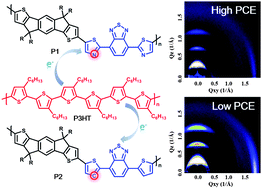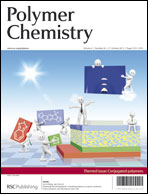Thiazole-containing electron-deficient unit DTABT as a building block was developed to construct donor–acceptor conjugated polymers (P1). Due to the strong electron withdrawing nature of DTABT, polymer P1 exhibited obviously lowered HOMO and LUMO levels relative to its thiophene-containing counterpart P2. Such low-lying LUMO level endowed P1 with high electron mobility, almost two orders of magnitude higher than P2. Meanwhile, balanced ambipolar transport behaviours of P1 were also observed in FET devices. All-polymer solar cells based on both polymers as acceptors were fabricated, in which P3HT/P1 blends showed power conversion efficiency twice as high as that of P3HT/P2. Further investigation showed that a P3HT/P1 blend film displayed smaller surface roughness and lower crystallinity of P3HT, indicating better miscibility of P3HT and P1. Compared to its thiophene-containing counterpart P2, P1 exhibited higher electron mobility and better miscibility with P3HT, and both advantages may together contribute to the significantly improved device performance of P1-based all-polymer solar cells.

You have access to this article
 Please wait while we load your content...
Something went wrong. Try again?
Please wait while we load your content...
Something went wrong. Try again?


 Please wait while we load your content...
Please wait while we load your content...